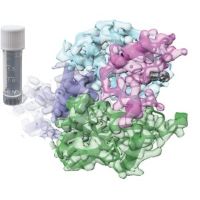Specification
| Description | Recombinant protein from the full-length sequence of Homo sapiens RING1 and YY1 binding protein (RYBP) (NM_012234). |
| Organism | Homo sapiens (Human) |
| Expression Host | Human Cells |
| Tag Info | His or DYKDDDDK. Please contact us if you need further information or require specific designed tag. |
| Purity | Greater than 90% by SDS-PAGE gel |
| Uniprot ID | Q8N488 |
| Entry Name | RYBP_HUMAN |
| Gene Names | RYBP DEDAF YEAF1 |
| Alternative Gene Names | DEDAF YEAF1 |
| Alternative Protein Names | RING1 and YY1-binding protein (Apoptin-associating protein 1) (APAP-1) (Death effector domain-associated factor) (DED-associated factor) (YY1 and E4TF1-associated factor 1) |
| Application | Antigens, Western, ELISA and other in vitro binding or in vivo functional assays, and protein-protein interaction studies; For research & development use only! |
| Buffer | Purified protein formulated in a sterile solution of PBS buffer, pH7.2, without any preservatives |
| Endotoxin | Endotoxin level is < 0.1 ng/µg of protein (<1EU /µg) |
| Length | 228 |
| Molecular Weight(Da) | 24822 |
| Protein Sequence | (The sequence of expressed protein may have some variation from the sequence shown below. Please contact us for the exact sequence.) MTMGDKKSPTRPKRQAKPAADEGFWDCSVCTFRNSAEAFKCSICDVRKGTSTRKPRINSQLVAQQVAQQYATPPPPKKEKKEKVEKQDKEKPEKDKEISPSVTKKNTNKKTKPKSDILKDPPSEANSIQSANATTKTSETNHTSRPRLKNVDRSTAQQLAVTVGNVTVIITDFKEKTRSSSTSSSTVTSSAGSEQQNQSSSGSESTDKGSSRSSTPKGDMSAVNDESF |
Background
| Function | FUNCTION: Component of a Polycomb group (PcG) multiprotein PRC1-like complex, a complex class required to maintain the transcriptionally repressive state of many genes, including Hox genes, throughout development. PcG PRC1-like complex acts via chromatin remodeling and modification of histones; it mediates monoubiquitination of histone H2A 'Lys-119', rendering chromatin heritably changed in its expressibility (PubMed:25519132). Component of a PRC1-like complex that mediates monoubiquitination of histone H2A 'Lys-119' on the X chromosome and is required for normal silencing of one copy of the X chromosome in XX females. May stimulate ubiquitination of histone H2A 'Lys-119' by recruiting the complex to target sites (By similarity). Inhibits ubiquitination and subsequent degradation of TP53, and thereby plays a role in regulating transcription of TP53 target genes (PubMed:19098711). May also regulate the ubiquitin-mediated proteasomal degradation of other proteins like FANK1 to regulate apoptosis (PubMed:14765135, PubMed:27060496). May be implicated in the regulation of the transcription as a repressor of the transcriptional activity of E4TF1 (PubMed:11953439). May bind to DNA (By similarity). May play a role in the repression of tumor growth and metastasis in breast cancer by down-regulating SRRM3 (PubMed:27748911). {ECO:0000250|UniProtKB:Q8CCI5, ECO:0000269|PubMed:11953439, ECO:0000269|PubMed:14765135, ECO:0000269|PubMed:19098711, ECO:0000269|PubMed:27060496, ECO:0000269|PubMed:27748911}. |
| Pathway | |
| Protein Families | |
| Tissue Specificity | Down-regulated in breast cancer tissues and in several breast cancer cell lines (at protein level) (PubMed:27748911). Widely expressed with highest levels in lymphoid tissues and placenta. {ECO:0000269|PubMed:11395500, ECO:0000269|PubMed:11953439, ECO:0000269|PubMed:14765135, ECO:0000269|PubMed:27748911}. |
QC Data
| Note | Please contact us for QC Data |
| Product Image (Reference Only) |  |

